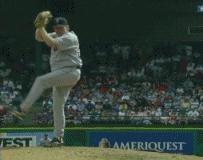I enjoyed watching Curt Schilling pitch in the later part of his 20 year career. I don’t remember hearing too much about Schilling prior to the 2004 American League Championship series against the Yankees; although he was very well known and respected by many before then. Schilling became very well known during Game 6 of the 2004 World Series because he was pitching with a hurt ankle and the announcers kept showing his blood soaked sock. That day he pitched 7 solid innings giving up one run on four hits, and striking out four. What a series!
Although I am a huge fan of Curt Schilling, I’m not writing this article to highlight what he accomplished during his incredible career. I want you to take a look at his solid pitching mechanics with this brief video clip.
I want to point out to you how long his stride is and how aggressive he is too foot strike. Look how Curt creates momentum toward the plate with his explosive push off and leverage he gets from leading with his front hip. I point this out because the majority of youth pitchers have a short stride and minimal hip rotation. The long stride and hip rotation is where the majority of velocity is created. Pay particular attention to schilling’s delayed shoulder rotation. Right before his front foot hits the ground (foot strike) he opens it up to help start his early hip rotation while keeping his shoulders in a closed position. This creates torque.
On his way toward home plate his head continues to stay over his center of gravity (belly button); this helps create the right type of momentum toward the plate. Some pitchers think velocity is created when they lean back toward second base. In reality, that is a great way to lose momentum as their energy is heading in a different direction. Pitchers need to keep their momentum headed toward the direction they are throwing as Curt demonstrates here.
For a total understanding of pitching mechanics, get your own copy of our Pitching Mechanics/Coaching Pitchers DVD Today!
https://www.thepitchingacademy.com/disc-one-pitching-mechanics-how-to-teach-pitchers/


